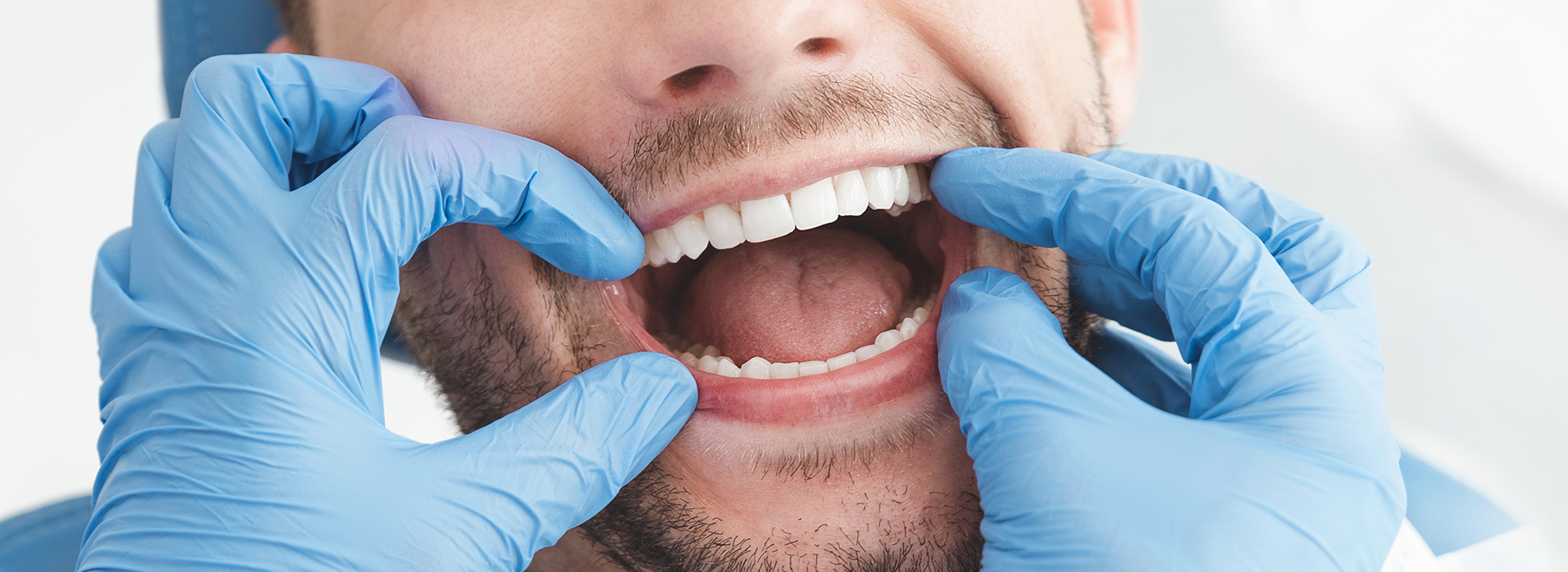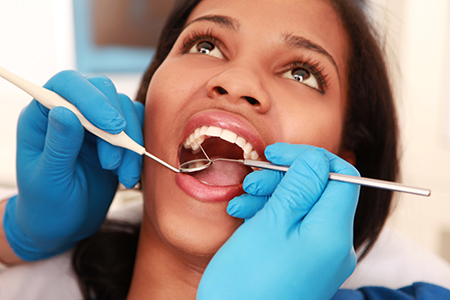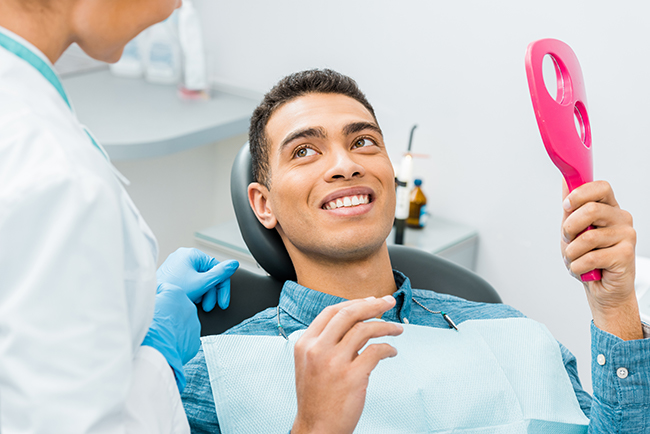
At the office of Newpoint Family Dental, we believe the best way to protect your smile is to be proactive. Regular oral exams give our team the information needed to detect small problems before they become complex, help you keep your mouth healthy, and guide personalized care for every member of your family. Our preventive services include thorough examinations, professional cleanings, oral cancer screenings, periodontal assessments, and practical guidance on oral hygiene and diet.
Your first comprehensive exam is our opportunity to learn about your dental history, current concerns, and health goals. We begin with a careful review of medical and dental histories and a conversation about any symptoms you may be experiencing. This context helps us interpret findings and choose the right diagnostic steps for your needs.
Next comes a focused clinical evaluation. We examine your teeth, gums, tongue, and the soft tissues of the mouth, and we assess bite alignment and TMJ (temporomandibular joint) function. When appropriate, we perform an oral cancer screening and a periodontal evaluation to check the health of the supporting structures around the teeth.
Diagnostic images are taken when necessary to see beneath the surface and document a baseline for future care. After the exam and any imaging, we’ll explain what we found in clear terms and recommend sensible next steps—if further treatment is needed—so you can make informed decisions about your oral health.

Oral health doesn’t exist in isolation. Conditions that affect teeth and gums can influence — and be influenced by — overall health. During routine exams we look for local signs that could relate to broader medical concerns, such as unusual oral lesions, persistent inflammation, or symptoms that suggest a systemic link.
Research increasingly shows connections between oral disease and systemic conditions. For example, chronic gum inflammation has been associated with cardiovascular issues and may complicate diabetes management. Identifying and managing oral disease early can therefore be part of supporting a patient’s wider health.
Conversely, changes in the body can show up in the mouth first. Dry mouth, unusual gum changes, or slow-healing sores sometimes point to underlying medical conditions or medication side effects. If we observe anything concerning, we’ll communicate our findings and, when appropriate, coordinate care with your physician to ensure a comprehensive approach.
Routine exams give us a chance to track changes over time, which is especially important for patients with chronic illnesses or those taking multiple medications. Those follow-up comparisons allow us to spot trends and intervene quickly when something changes.

The foundation of a healthy smile combines effective home care with regular professional maintenance. Even the most diligent brushing and flossing can miss microscopic plaque and hardened deposits that form in hard-to-reach places. Professional cleanings remove these deposits and reduce the bacteria that cause cavities and gum disease.
Beyond removing buildup, checkups provide structured opportunities for monitoring your oral tissues, refreshing homecare instruction, and catching early signs of trouble when they are easiest to treat. We tailor the interval and content of checkups to each patient’s risk profile, focusing on prevention and long-term stability.
Dental hygienists play a central role in preventive care. During an appointment they assess your homecare routine, demonstrate targeted techniques, and apply preventive treatments when appropriate. Together, this combination of professional attention and patient education helps preserve natural teeth and maintain comfort and function.
For children, regular exams are also a time to monitor growth and development, reinforce good habits, and identify whether orthodontic guidance may be beneficial as their jaws and teeth mature.
Many dental conditions begin below the surface, out of sight of a routine visual inspection. Dental x-rays are an essential diagnostic tool because they reveal hidden decay, early bone changes, and the alignment and health of tooth roots and supporting structures. When paired with a clinical exam, radiographs give a fuller picture of oral health.
Modern practices use digital radiography, which captures images quickly with minimal radiation exposure and immediate image availability. These digital images can be stored in a patient’s record, magnified for a closer look, and shared with specialists when collaborative care is needed.
We use x-rays judiciously—choosing the right image type for each clinical situation—so that you receive the diagnostic benefit without unnecessary exposure. Digital images also help with planning restorative or surgical care and tracking changes over time for patients with ongoing conditions.

The specific radiographs we recommend depend on your symptoms, age, and the clinical questions we need to answer. Each image type serves a different purpose and helps us make accurate, efficient diagnoses.
Periapical x-ray - Focuses on a single tooth from crown to root, revealing root tips and adjacent bone for issues such as abscesses or root abnormalities.
Bitewing x-ray - Captures the crowns of the back teeth and is especially useful for detecting early decay between teeth.
Full Mouth Series - A comprehensive set of bitewing and periapical views that documents the condition of all teeth and surrounding bone.
Panoramic Film (panorex) - Provides a broad, two-dimensional view of both jaws and all teeth, useful for evaluating development, impacted teeth, and jawbone health.
Cephalometric Film - A profile view of the head used primarily in orthodontic assessment and treatment planning.
For complex planning—such as implant placement or advanced surgical cases—we may recommend three-dimensional imaging with cone-beam computed tomography (CBCT). CBCT offers detailed views of bone anatomy and spatial relationships that help improve accuracy and predictability in treatment planning.
Regular oral exams are the cornerstone of lasting oral health. By combining careful clinical assessment, targeted imaging, and education, our team creates a clear roadmap for prevention and treatment. If you have questions about what to expect during an exam or would like to discuss how often you should be seen, please contact us for more information.
During a comprehensive oral exam the dentist and hygienist review your medical and dental history and ask about any symptoms or concerns you may have. They perform a thorough clinical evaluation of the teeth, gums, tongue and other soft tissues while assessing bite alignment and temporomandibular joint function. This exam often includes a periodontal assessment and an oral cancer screening so that any areas of concern are identified early.
When indicated, diagnostic images are taken to reveal conditions that cannot be seen during a visual exam and to establish a baseline for future care. The team documents findings clearly and explains recommended next steps in plain language so you can make informed decisions about treatment or preventive measures. Follow-up plans and any necessary referrals are arranged before you leave so your care is coordinated and efficient.
Most patients benefit from routine oral exams at regular intervals, but the exact frequency depends on individual risk factors such as a history of cavities, gum disease, medical conditions or medications. For many adults and children, twice-yearly visits provide reliable preventive oversight, while others may need more frequent monitoring based on clinical findings. Your provider will discuss a personalized schedule after assessing your oral health and overall risk profile.
Risk-based scheduling allows the team to focus resources where they matter most and to intervene earlier when problems are emerging. If your health status changes or you start new medications, your exam interval may be adjusted to reflect new needs. The goal is to maintain stability and catch changes early, reducing the need for more complex treatment later on.
Oral exams are a window into overall health because many systemic conditions produce signs in the mouth before they appear elsewhere. Chronic gum inflammation and persistent oral infections can influence systemic inflammation and are associated with conditions such as diabetes and cardiovascular disease, making early detection and control important. Identifying oral manifestations of systemic issues helps clinicians recommend appropriate medical follow-up when necessary.
Conversely, changes in oral tissues can signal medication side effects, nutritional deficiencies or undiagnosed medical conditions, so routine exams support broader health monitoring. When the dental team observes findings that suggest a medical concern, they communicate those observations and, with your permission, coordinate care with your physician. Regular oral exams thus contribute to an integrated approach that supports both oral and overall well-being.
Clinical evaluation remains the foundation of the oral exam, but clinicians commonly use adjunctive tools such as periodontal probing, an intraoral camera and digital images to document findings more precisely. These tools enhance visibility, allow detailed patient education, and create records that can be compared over time to track changes. When needed, the team also employs specialized imaging such as cone-beam computed tomography for three-dimensional assessment of complex cases.
Each tool is selected to answer specific clinical questions while minimizing unnecessary procedures or exposure. Digital records can be magnified, annotated and shared with specialists to support collaborative care when treatment planning requires input beyond the office. The result is a more accurate diagnosis and a clearer plan for prevention or treatment.
Yes, oral cancer screenings are an important component of most routine exams and involve a careful visual and tactile evaluation of the lips, tongue, floor of mouth and other soft tissues. The clinician looks for asymmetries, persistent sores, unexplained white or red patches and other changes that warrant closer monitoring or further testing. Early detection improves the ability to manage disease and facilitates timely referral when specialist care is needed.
If a suspicious lesion is identified, the team documents its appearance, size and location, discusses next steps with you, and may recommend biopsy, imaging or referral to an oral medicine or head and neck specialist. Screening is quick, noninvasive and integrated into the standard exam so that any concerning signs are identified as early as possible. Patients with risk factors such as tobacco use or a history of significant sun exposure may receive more frequent surveillance.
Dental x-rays reveal conditions that are not visible during a visual inspection, including early decay between teeth, root problems, bone loss and the position of teeth below the gumline. When paired with the clinical exam, radiographs provide a fuller picture that supports accurate diagnosis and informed treatment planning. Modern digital radiography captures images quickly, reduces radiation exposure and makes it easier to compare images over time.
Different image types serve different purposes, so the team selects bitewings, periapicals, panoramic images or three-dimensional scans based on the clinical question. Digital images are stored in the patient record and can be shared with specialists for coordinated care when needed. X-rays are used judiciously to balance diagnostic benefit with patient safety and comfort.
For your first visit bring a list of current medications, relevant medical history and any concerns or symptoms you want to discuss with the clinician. If you have recent dental records or radiographs from another office, bringing those materials or arranging a transfer can help the team avoid duplicate imaging and provide continuity of care. A short list of questions you want answered also helps ensure the visit covers what matters most to you.
If you are visiting from outside the area, plan to arrive a few minutes early to complete any new-patient paperwork and to confirm your history. Newpoint Family Dental is located at 123 Dwight Rd., Longmeadow, MA 01106, and arriving on time allows staff to review your records and begin the clinical portion of the exam promptly. The team will review findings with you at the end of the visit and outline any recommended follow-up or preventive steps.
Exams for younger patients focus on growth and development, monitoring eruption patterns, jaw alignment and the early detection of issues that could affect future oral health. Clinicians assess habits such as thumb-sucking, tongue thrusting and mouth breathing and discuss age-appropriate hygiene instruction that encourages good lifelong habits. Orthodontic screening is incorporated as needed so potential alignment concerns can be identified while growth is still favorable for intervention.
Preventive strategies such as dental sealants and fluoride applications may be recommended when appropriate to reduce decay risk in vulnerable teeth. The frequency and content of visits are adjusted to the child’s developmental stage and individual risk factors, allowing the dental team to support healthy growth with gentle, age-appropriate care. Parent education and clear communication are central to building cooperative, long-term dental habits.
The dentist may recommend more frequent exams for patients with active periodontal disease, a history of rapid decay, certain medical conditions that affect oral health, or medications that reduce saliva and increase risk. Smoking, pregnancy and compromised immune function are additional factors that typically prompt closer monitoring. Increasing the frequency of visits helps control disease activity and allows the team to respond quickly if problems worsen.
For patients undergoing treatment that requires close supervision—such as periodontal therapy or complex restorative work—the office will create a maintenance schedule tailored to treatment goals and healing needs. Shorter recall intervals also provide opportunities for reinforcement of homecare techniques and timely preventive treatments. The objective is to stabilize the condition and then extend intervals as health improves.
The practice uses a combination of clinical charting, digital radiographs and intraoral images to create a comprehensive record for each patient that can be compared across visits. These records allow clinicians to track subtle changes in soft tissues, tooth structure and supporting bone so that any trend toward disease can be identified early. Detailed documentation also supports clear communication with specialists when collaborative care is required.
Electronic records and imaging make it easier to establish baselines, set goals for treatment and monitor outcomes, while recall systems help ensure patients return at appropriate intervals. When the team identifies a change that warrants action, they discuss findings, propose next steps and schedule follow-up so care remains coordinated and proactive. This systematic approach helps preserve oral health and supports long-term stability.
Our mission is to help every patient enjoy healthy teeth and a confident smile, providing care that meets your needs and exceeds expectations.
